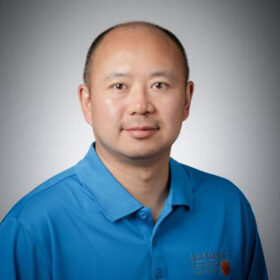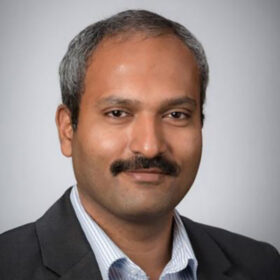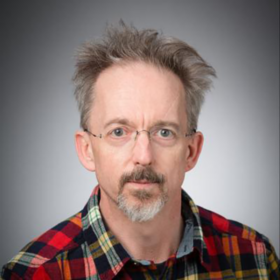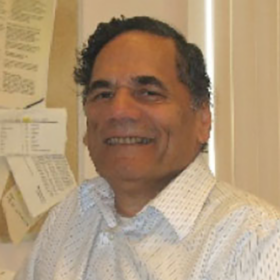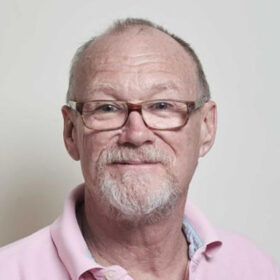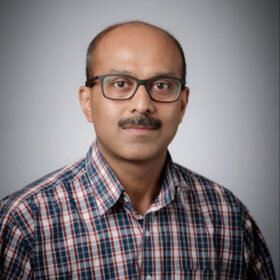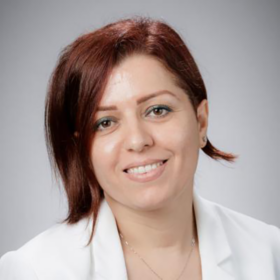-
3 unit(s)
Staff (cross-listed as ECE 6BC3)
Introduction to mathematical and engineering methods for describing and predicting the behaviour of biological systems; including sensory receptors, neuromuscular and biomechanical systems; statistical models of biological function; kinetic models of biological thermo-dynamics. -
3 unit(s)
(cross-listed as ECE 6BE4)
Fundamentals of robotics and telerobotics; feedback from the environment using sensors and machine vision; application of robotics to medicine and surgery. -
3 unit(s)
This course covers the basic principles of light interaction with biological systems and specific biomedical applications of photonics such as optical light microscopy, endoscopic imaging, spectroscopy in clinical diagnosis, flow cytometry, micro-optical sensors, etc.
Three lectures; second term
Prerequisite(s): Registration in Level III or above in the Faculties of Engineering, Science, or Health Sciences, or the Integrated Biomedical Engineering & Health Sciences (IBEHS) Program
Cross-list(s): MEDPHYS 4I03 -
3 unit(s) (cross-listed as CHEM ENG 6T03)
Applications of chemical engineering principles to biological systems and medical problems including examples from hemodynamics, blood oxygenation, artificial kidney systems, controlled drug release, biosensors and biomaterials.
Three lectures; second term
Prerequisite(s): One of CHEM ENG 2O04 (or 3O04), ENG PHYS 3O03, ENG PHYS 3O04 or MECH ENG 3O04
Cross-list: BIOMED 6T03/CHEM ENG 4T03 -
3 unit(s)
Staff (cross-listed as ECE 6TN3)
Digital image formation and representation; filtering, enhancement and restoration; edge detection; discrete image transforms; encoding and compression; segmentation; recognition and interpretation; 3D imagery; applications. -
3 unit(s)(cross-listed as CHEM ENG 6Z03)
The physics and chemistry at the “nano” scale including interactions forces, colloids, surface active systems, wetting, adhesion, and flocculation.
Cross-listed: BIOMED 6Z03/CHEM ENG 4Z03/CHEM ENG 6Z03/ -
3 unit(s) An introduction to biomedical engineering. The biological, chemical, electrical, and mechanical principles involves the design and operation of medical devices and bioprocesses. The research themes of the School of Biomedical Engineering are emphasized: biomaterials and tissue engineering; biomedical imaging; biomedical technology (e.g. biophotonics and medical robotics); bioprocessing.
-
3 unit(s)
(cross-listed as ECE 780 and MED PHYS 702 and BIOMED 702)
This course will compliment Medical Imaging Systems I. In this course imaging methods that rely on non-ionizing radiation will be discussed. The course content focuses on magnetic resonance imaging (MRI), in vivo nuclear magnetic resonance (NMR), ultrasound (US), and optical imaging methods. Advanced concepts such as multi-modality imaging approaches, image fusion, and functional medical image processing will be discussed. -
-
3 unit(s)
Incorporation of systematic errors in the standard model of Magnetic Resonance Imaging.Analysis of the resulting artifacts, methods of calibration and correction. -
3 unit(s)
Each week in this course an invited radiologist will speak on the current state of the art in a particular area of diagnostic medical imaging (e.g., musculoskeletal radiology, neuroradiology, interventional radiology, etc.). They will outline the approaches they use to diagnose and grade disease and the limitations of the technology, as they see it from a clinical perspective. This presentation will be followed (on a different day) by a synopsis and open discussion on how the technology is used, the limitations, and potential avenues or approaches on how students would improve the technology for better assessing disease. -
3 unit(s)
H. Sheardown, M. Noseworthy, P. Margetts, T. Hoare, J. West-Mays (cross-listed as CHEM ENG 781)
An introduction to biomedical engineering with a health science focus. The biological and chemical concepts involved in the design and operation of medical devices and biological processes will be discussed. The following research themes will be emphasized: cell biological responses to biomaterials, toxicity / pharmacokinetics, tissue and genetic engineering, gene therapy, biotechnology physiological response to biomaterials. -
3 unit(s)
Qiyin Fang, Michael S. Patterson, Joseph E. Hayward, and Thomas Farrell
Prerequisite(s): BIOMED 6I03 / Introduction to Biophotonics
To provide an in-depth understanding of the physics behind a selected number of biophotonics applications in life sciences (e.g. fluorescence lifetime imaging, high content screening, etc.) and clinical applications (diffuse optical tomography, time-resolved fluorescence spectroscopy, optical coherent tomography, photoacoustic microscopy, etc.) as well as key tools used these research areas including ImageJ, image processing, and pattern recognition and classification.
Cross-listed: BIOMED 707/ENG PHYS 709 -
(cross-listed: BIOMED 708/ MATLS 703)
This course will introduce students to the various classes of biomaterials and their associated properties, including metallic, ceramic, polymeric, and nanomaterials. We will explore topics in material-tissue interactions, and techniques for biomaterials testing and characterization. Current applications of biomaterials and the clinical context of their use will be introduced -
(cross-listed as NURSING 709 and MED SCI 707 )
This course focuses on the main statistical issues that might be useful in health research. It will introduce statistical techniques in such a way that students will grasp the fundamentals to enable them to gain the confidence to perform their own analysis. It also provides sufficient instruction in areas such as clinical trials and epidemiology to enable them to critically appraise journal articles. -
Cross-listed: BIOMED 712/ECE 712
Matrix decompositions: eigen-decomposition, QR decomposition, singular value decomposition; solution to systems of equations: Gaussian elimination, Toeplitz systems; least square methods: ordinary, generalized and total least squares, principal component analysis. -
-
3 unit(s) Topics include mechanics of biological tissues, injury/failure mechanisms (particularly musculoskeletal tissues and brain injury), and theory behind methods and devices for prevention of injuries with particular focus on motor vehicle collisions and sport-related injuries.
Cross-listed: MECHENG 715 / BIOMED 715
TERM 2 -
3 unit(s) Current techniques and technologies used in orthopaedic biomechanics and their applications and limitations, including joint replacement design and failure, analysis of human locomotion, numerical methods in biomechanics, computer assisted surgery, and design of assistive devices.
Cross-listed: MECHENG 717 / BIOMED 717
TERM 2 -
-
3 unit(s)
Cross-listed: BIOMED 742/CHEM ENG 742
Overview of bioseparation processes; introduction to membrane technology; principles of microfiltration; microfiltration based bioseparation processes; theory of ultrafiltration; ultrafiltration based bioseparation processes; nanofiltration–theory and applications; bioseparation using membrane adsorbers; dialysis–theory and applications; integrated processes e.g. membrane bioreactors; use of membranes in analytical biotechnology; membrane based drug delivery systems; biomimetic membranes. -
-
This course covers circulatory anatomy and physiology as well as several methods for modeling circulatory mechanics. Some applications of modeling circulatory mechanics in the development of medical devices are also covered. The major topics to be covered include: Introduction to anatomy and physiology of cardiovascular system; Introduction to anatomy and physiology of local circulations such as cerebral, pulmonary and renal circulations; Blood rheology; Flow, pressure and wave reflection in the circulatory system; Governing equations for solid deformation; Governing equations for fluid motion; Analytical solutions; Medical imaging technologies; Medical imaging data used for modeling; Solid mechanics models; Fluid mechanics models; Fluid-solid mechanics models; Numerical modeling of wave propagation; Lumped parameter mathematical models.
Cross-listed: MECHENG 762 / BIOMED 762 / CSE 763
TERM 2 -
3 unit(s) M. Noseworthy (cross-listed as MED SCI 765) Functional brain imaging using magnetic resonance techniques (MIR, and in vivo NMR) will be thoroughly discussed. Advantages and disadvantages, relative to other brain imaging modalities (CT, PET, SPECT, NIRS, US) will be discussed where appropriate. This course will provide students with an appropriate, yet complete, understanding of the underlying physics surrounding magnetic resonance and its relevance to neuroscience for the design of functional brain imaging experiments.
-
MED PHYS 770 / Medical Imaging Systems I 3 unit(s) (cross-listed as BIOMED *770 and ECE 779 ) Medical imaging is important for both clinical medicine, and medical research. This course will provide an introduction to several of the major imaging modalities, focusing on the aspects of imaging physics, signal processing and system design. The topics to be covered include projection-imaging systems (projection X-Ray), backprojection based systems (CT, PET, and SPECT). Ultrasound, optical imaging and MRI will be covered in the second part of this course Medical Imaging System II.
-
Mark Inman (cross-listed as MEDSCI 771 ) This course addresses the basic principles underlying the “science” of research, as it relates to Health Science. The topics covered in the course include: the philosophy of science, generating hypotheses and specific questions, experimental design, evaluation and validation of measurement techniques, how to “look” at your data, statistical considerations (focussing on the basic concepts behind mean comparisons, correlation and regression), displaying your data, interpreting your data appropriately, communicating your data to others. The course will involve 12 sessions. Readings will prepare students for each session, which will involve about 50% didactic presentation and 50% discussion of relevant examples or cases – often from the students’ own work.
-
3 unit(s)
The course is designed to give the student a more detailed knowledge of engineering applications to sensory and neuromuscular physiology. Topics include models of the myelinated and unmyelinated nerves including applied stimulating electrical fields; electrical fields in tissue resulting from surface and subcutaneous applied stimuli; surface and subcutaneous electrical fields in tissue resulting from single or populations of active nerve or muscle fibers; models of neuromuscular control; acquisition and analysis of kinesiological electromyographic and electroneurographic signals to determine normal and pathological neuromuscular function; magnetic and electrical stimulation of neural structures; Functional Electrical Stimulation (FES) and Magnetic Stimulation (FMS) in rehabilitation; neuroprostheses and sensory system interfaces. -
3 unit(s)
Fundamentals of the design, preparation, and properties of nanomaterials are discussed from a chemical engineering perspective. Emphasis will be placed on how physical properties of materials change on the nanoscale, top-down (chemical patterning/lithography techniques) versus bottom-up (self-assembly) approaches to nanostructure preparation, nanoparticle design, characterization of nanoscale structures, nanofluidics and nanomachines (including microelectromechanical systems) and nanobiomaterials (drug and gene delivery, biosensors and bioseparations). -
3 unit(s)
This course allows students to undertake advanced study in selected topics relevant to their thesis research. The student identifies a topic and studies under the guidance of a faculty member who has the relevant expertise. The pertinent literature is examined critically. -
3 unit(s) Cross-listed
This course provides a solid conceptual and quantitative background in the modeling of biological neurons and how they function as computational devices. Practical experience will be gained in modeling neurons from a number of perspectives, including equivalent electrical circuits, nonlinear dynamical systems, and random point-processes, and an introduction to the mathematics required to understand and implement these different engineering methodologies will be given.


